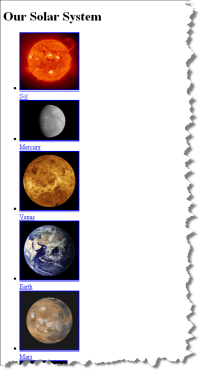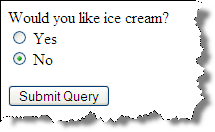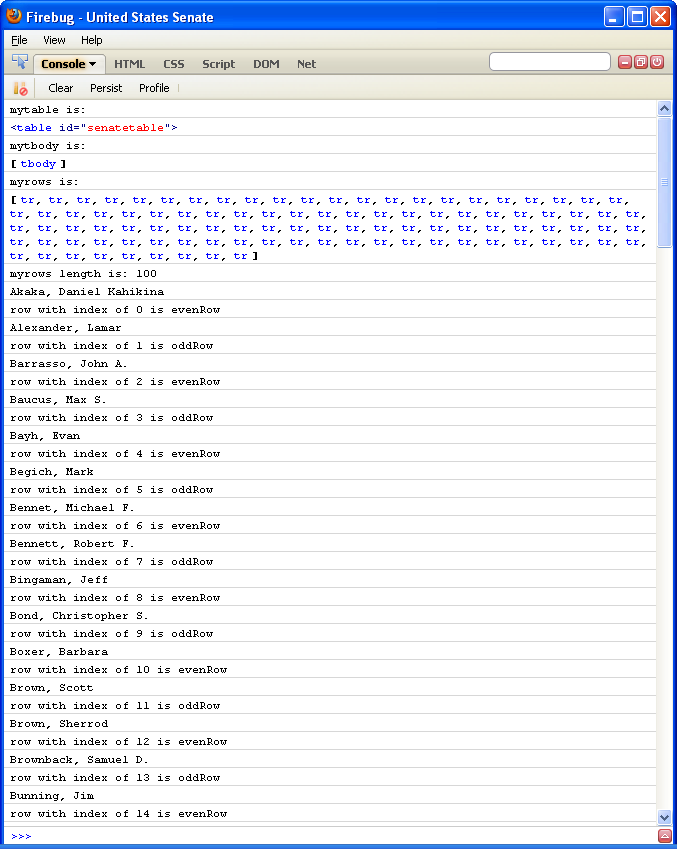
- Markup (HTML)
- Structure
- Content
- Style (CSS)
- Style
- Presentation
- Appearance
- Function (JavaScript)
- Actions
- Manipulations
Structure + Style + Function: solarsystem.html
Structure + Style: solarsystem-style.html
Structure: solarsystem-markup.html
Harvard University
Extension School
Course Web Site: http://cscie12.dce.harvard.edu
Instructor email:
david_heitmeyer@harvard.edu
Course staff email:
cscie12@dce.harvard.edu
| Structure + Style + Function: solarsystem.html Structure + Style: solarsystem-style.html Structure: solarsystem-markup.html |
"JavaScript is now a language every developer should know."
– Mike Loukides, Vice President of Content Strategy for O'Reilly Media
JavaScript is everywhere: servers, rich web client libraries, HTML5, databases, even JavaScript-based languages. If you've avoided JavaScript, this is the year to learn it. And if you don't, you risk being left behind.
Javascript provides programmatic access to virtually all aspects of a page.



The standard for JavaScript is called ECMAScript.
onclick="document.getElementById('simple1a').style.backgroundColor='#ff33ff';"document.getElementById('simple1a').style.backgroundColor='#ff33ff';document - the web page loaded in the browsergetElementById('simple1a') - finds the element based upon the value of the "id" attribute (id="simple1a")style - the style properties of an elementbackgroundColor='#ff33ff' - assigns the 'background-color' style property to the given value<p><a href="#" onclick="document.getElementById('simple1a').style.backgroundColor='#ff33ff';">Change background color</a></p>
<p id="simple1a">Lorem ipsum dolor sit amet, consectetur adipiscing elit. Nunc lobortis orci a odio. Donec cursus, felis eu pulvinar ornare, sem turpis dapibus elit, eget laoreet eros quam vel dolor. Ut ante mauris, ullamcorper quis, posuere quis, lacinia a, felis. In tincidunt malesuada pede. Donec varius lacus sed nisi. Donec rhoncus est ac erat. Duis lobortis fringilla eros. Donec volutpat ligula eu neque. In hac habitasse platea dictumst. Donec in massa. Aenean lectus ante, gravida et, luctus id, posuere at, pede. Nam risus orci, rhoncus eu, aliquam ut, interdum ut, orci. Suspendisse rutrum, turpis sed molestie gravida, libero risus iaculis ligula, quis tempor ligula enim vel sem.</p>
In style
element
(<style type="text/css">) within head element:
body {font-family: Calibri,Tahoma,Verdana,Helvetica,sans-serif;}
#simple1a {
padding: 1em;
border: medium solid black;
width: 75%;
}
Lorem ipsum dolor sit amet, consectetur adipiscing elit. Nunc lobortis orci a odio. Donec cursus, felis eu pulvinar ornare, sem turpis dapibus elit, eget laoreet eros quam vel dolor. Ut ante mauris, ullamcorper quis, posuere quis, lacinia a, felis. In tincidunt malesuada pede. Donec varius lacus sed nisi. Donec rhoncus est ac erat. Duis lobortis fringilla eros. Donec volutpat ligula eu neque. In hac habitasse platea dictumst. Donec in massa. Aenean lectus ante, gravida et, luctus id, posuere at, pede. Nam risus orci, rhoncus eu, aliquam ut, interdum ut, orci. Suspendisse rutrum, turpis sed molestie gravida, libero risus iaculis ligula, quis tempor ligula enim vel sem.
function setBackgroundColor() {
document.getElementById('simple1b').style.backgroundColor = '#ff33ff';
}<p><a href="#" onclick="setBackgroundColor();">Change background color</a></p>
<p id="simple1b">Lorem ipsum dolor sit amet, consectetur adipiscing elit. Nunc lobortis orci a odio. Donec cursus, felis eu pulvinar ornare, sem turpis dapibus elit, eget laoreet eros quam vel dolor. Ut ante mauris, ullamcorper quis, posuere quis, lacinia a, felis. In tincidunt malesuada pede. Donec varius lacus sed nisi. Donec rhoncus est ac erat. Duis lobortis fringilla eros. Donec volutpat ligula eu neque. In hac habitasse platea dictumst. Donec in massa. Aenean lectus ante, gravida et, luctus id, posuere at, pede. Nam risus orci, rhoncus eu, aliquam ut, interdum ut, orci. Suspendisse rutrum, turpis sed molestie gravida, libero risus iaculis ligula, quis tempor ligula enim vel sem.</p>
In style
element
(<style type="text/css">) within head element:
body {font-family: Calibri,Tahoma,Verdana,Helvetica,sans-serif;}
#simple1b {
padding: 1em;
border: medium solid black;
width: 75%;
}
In
script element within head element (<script type="text/javascript">):
function setBackgroundColor() {
document.getElementById('simple1b').style.backgroundColor = '#ff33ff';
}function setBackgroundColor() {
document.getElementById('simple2').style.backgroundColor = '#ff33ff';
}Two steps.
function setBackgroundColor() {
mynode = document.getElementById('simple2');
mynode.style.backgroundColor = '#ff33ff';
}Two steps. Using variables to define "id" and color.
function setBackgroundColor() {
var myid = 'simple2';
var mycolor = '#ff33ff';
mynode = document.getElementById(myid);
mynode.style.backgroundColor = mycolor;
}<p><a href="#" onclick="setBackgroundColor();">Change background color</a></p>
<p id="simple2">Lorem ipsum dolor sit amet, consectetur adipiscing elit. Nunc lobortis orci a odio. Donec cursus, felis eu pulvinar ornare, sem turpis dapibus elit, eget laoreet eros quam vel dolor. Ut ante mauris, ullamcorper quis, posuere quis, lacinia a, felis. In tincidunt malesuada pede. Donec varius lacus sed nisi. Donec rhoncus est ac erat. Duis lobortis fringilla eros. Donec volutpat ligula eu neque. In hac habitasse platea dictumst. Donec in massa. Aenean lectus ante, gravida et, luctus id, posuere at, pede. Nam risus orci, rhoncus eu, aliquam ut, interdum ut, orci. Suspendisse rutrum, turpis sed molestie gravida, libero risus iaculis ligula, quis tempor ligula enim vel sem.</p>
In style
element
(<style type="text/css">) within head element:
body {font-family: Calibri,Tahoma,Verdana,Helvetica,sans-serif;}
#simple2 {
padding: 1em;
border: medium solid black;
width: 75%;
}
In
script element within head element (<script type="text/javascript">):
function setBackgroundColor() {
myid = 'simple2';
mycolor = '#ff33ff';
mynode = document.getElementById(myid);
mynode.style.backgroundColor = mycolor;
}Two steps. Using variables to define "id" and color.
function setBackgroundColor() {
var myid = 'simple2';
var mycolor = '#ff33ff';
var mynode = document.getElementById(myid);
mynode.style.backgroundColor = mycolor;
}Passing in values for "id" and "color" when calling the function.
function setBackgroundColor(myid,mycolor) {
mynode = document.getElementById(myid);
mynode.style.backgroundColor = mycolor;
}<p><a href="#" onclick="setBackgroundColor('simple3','#33ffff');">Change background color</a></p>
<p id="simple3">Lorem ipsum dolor sit amet, consectetur adipiscing elit. Nunc lobortis orci a odio. Donec cursus, felis eu pulvinar ornare, sem turpis dapibus elit, eget laoreet eros quam vel dolor. Ut ante mauris, ullamcorper quis, posuere quis, lacinia a, felis. In tincidunt malesuada pede. Donec varius lacus sed nisi. Donec rhoncus est ac erat. Duis lobortis fringilla eros. Donec volutpat ligula eu neque. In hac habitasse platea dictumst. Donec in massa. Aenean lectus ante, gravida et, luctus id, posuere at, pede. Nam risus orci, rhoncus eu, aliquam ut, interdum ut, orci. Suspendisse rutrum, turpis sed molestie gravida, libero risus iaculis ligula, quis tempor ligula enim vel sem.</p>
In style
element
(<style type="text/css">) within head element:
body {font-family: Calibri,Tahoma,Verdana,Helvetica,sans-serif;}
#simple3 {
padding: 1em;
border: medium solid black;
width: 75%;
}
In
script element within head element (<script type="text/javascript">):
function setBackgroundColor(myid,mycolor) {
mynode = document.getElementById(myid);
mynode.style.backgroundColor = mycolor;
}<input type="text" id="background_color" />.value<p>Background color:
<input type="text" id="background_color"/><br/><button onclick="setBackgroundColor('simple4');" type="submit">Set background color</button></p>
<p id="simple4">Lorem ipsum dolor sit amet, consectetur adipiscing elit. Nunc lobortis orci a odio. Donec cursus, felis eu pulvinar ornare, sem turpis dapibus elit, eget laoreet eros quam vel dolor. Ut ante mauris, ullamcorper quis, posuere quis, lacinia a, felis. In tincidunt malesuada pede. Donec varius lacus sed nisi. Donec rhoncus est ac erat. Duis lobortis fringilla eros. Donec volutpat ligula eu neque. In hac habitasse platea dictumst. Donec in massa. Aenean lectus ante, gravida et, luctus id, posuere at, pede. Nam risus orci, rhoncus eu, aliquam ut, interdum ut, orci. Suspendisse rutrum, turpis sed molestie gravida, libero risus iaculis ligula, quis tempor ligula enim vel sem.</p>
In style
element
(<style type="text/css">) within head element:
body {font-family: Calibri,Tahoma,Verdana,Helvetica,sans-serif;}
#simple4 {
padding: 1em;
border: medium solid black;
width: 75%;
}
In
script element within head element (<script type="text/javascript">):
function setBackgroundColor(myid) {
mynode = document.getElementById(myid);
mycolor = document.getElementById('background_color').value;
mynode.style.backgroundColor = mycolor;
}| Event | Event Attribute |
|---|---|
| click | onclick |
| change | onchange |
| submit | onsubmit |
| load | onload |
| mouseover | onmouseover |
| mouseout | onmouseout |
| focus | onfocus |
| blur | onblur |
| select | onselect |
| dblclick | ondblclick |
| keydown | onkeydown |
| keyup | onkeyup |
| keypress | onkeypress |
| unload | onunload |
| mousedown | onmousedown |
| mousemove | onmousemove |
| mouseup | onmouseup |
| reset | onreset |
function setBackgroundColor(myid,mycolor) {
mynode = document.getElementById(myid);
mynode.style.backgroundColor = mycolor;
} <ul>
<li><a href="#" onclick="setBackgroundColor('p1','#ff3333');">Click to make "red"</a></li>
<li><a href="#" onclick="setBackgroundColor('p1','#3333ff');">Click to make "blue"</a></li>
<li><a href="#" ondblclick="setBackgroundColor('p1','#33ff33');">Double Click to make "green"</a></li>
<li><a href="#" onmouseover="setBackgroundColor('p1','#ffff33');" onmouseout="setBackgroundColor('p1','#cccccc');">Mouseover to make "yellow" and mouseout to make "gray"</a></li>
<li><a href="#" onkeypress="setBackgroundColor('p1','#ff33ff');">Keypress to make "magenta"</a></li>
</ul><p id="p1">Lorem ipsum dolor sit amet, consectetur adipiscing elit. Nunc lobortis orci a odio. Donec cursus, felis eu pulvinar ornare, sem turpis dapibus elit, eget laoreet eros quam vel dolor. Ut ante mauris, ullamcorper quis, posuere quis, lacinia a, felis. In tincidunt malesuada pede. Donec varius lacus sed nisi. Donec rhoncus est ac erat. Duis lobortis fringilla eros. Donec volutpat ligula eu neque. In hac habitasse platea dictumst. Donec in massa. Aenean lectus ante, gravida et, luctus id, posuere at, pede. Nam risus orci, rhoncus eu, aliquam ut, interdum ut, orci. Suspendisse rutrum, turpis sed molestie gravida, libero risus iaculis ligula, quis tempor ligula enim vel sem.</p>
In style
element
(<style type="text/css">) within head element:
body {font-family: Calibri,Tahoma,Verdana,Helvetica,sans-serif;}
#p1 {
padding: 1em;
border: medium solid black;
width: 75%;
}
In
script element within head element (<script type="text/javascript">):
function setBackgroundColor(myid,mycolor) {
mynode = document.getElementById(myid);
mynode.style.backgroundColor = mycolor;
return false;
}

<script> element
src attribute)
script element
<script> element can go in head, but is often placed just before the body close (i.e. </body>) elements.<noscript> element for clients without JavaScript.script element should have an explicit end tag.
Best:
<script src="jquery.js" type="text/javascript" > </script><script src="jquery.js" type="text/javascript" /><script src="path/to/javascript/file.js" type="text/javascript" > </script><script type="text/javascript">
/*
JavaScript code as content of script element
*/
</script><a href="#"
onclick="javascript:void(window.resizeTo(1024,768))">
Size Window to 1024 x 768
</a>Additional relevant form elements are exposed based upon user input.
Here, this is achieved by having the entire form in the markup, with a certain section
hidden via CSS (display: none;). If "Yes" is chosen,
the display property is changed to "block" through JS.
<form method="get" name="ice_cream" id="ice_cream" action="http://cscie12.dce.harvard.edu/echo">
<div>Would you like ice cream?<br/>
<input type="radio" name="want" id="ic_yes" value="yes" onclick="displayIceCreamOptions()"/><label for="ic_yes">Yes</label><br/>
<input type="radio" name="want" id="ic_no" value="no" onclick="displayIceCreamOptions()"/><label for="ic_no">No</label></div><fieldset id="icecream_options" style="display: none;"><legend>Ice Cream Options</legend><p>How would you like it?</p>
<input type="radio" id="container_cup" name="container" value="cup"/><label for="container_cup">Cup</label><br/>
<input type="radio" id="container_cone" name="container" value="cone"/><label for="container_cone">Cone</label><br/><p>Pick your toppings:</p>
<input type="checkbox" name="toppings" id="toppings_wc" value="whipcream"/><label for="toppings_wc">Whipped cream</label><br/>
<input type="checkbox" name="toppings" id="toppings_j" value="jimmies"/><label for="toppings_j">Jimmies</label><br/>
<input type="checkbox" name="toppings" id="toppings_nuts" value="nuts"/><label for="toppings_nuts">Nuts</label><br/>
<input type="checkbox" name="toppings" id="toppings_cherry" value="cherry"/><label for="toppings_cherry">Cherry</label></fieldset><p>
<input type="submit"/></p>
</form>
In style
element
(<style type="text/css">) within head element:
#icecream_options {
display:none;
background-color: #eee;
margin-left: 2em;
}
In
script element within head element (<script type="text/javascript">):
function displayIceCreamOptions() {
var divico = document.getElementById('icecream_options');
var inputYes = document.getElementById('ic_yes');
if (inputYes.checked == true) {
divico.style.display = 'block';
} else {
divico.style.display = 'none';
}
}

Validate form input using the onsubmit event attribute.
Things to note:
onsubmit attribute to set handler for "submit" eventfalse stops the form submissionthis refers to the instance of the object (the form)<form onsubmit="return Validate(this)" method="get" action="http://cscie12.dce.harvard.edu/echo">
<div><label for="YourName1">Enter your name</label>:
<input type="text" id="YourName1" name="YourName"/><br/>
<input type="submit" value="Submit Information"/></div>
</form>
In
script element within head element (<script type="text/javascript">):
function Validate(myForm) {
console.log(myForm);
if(myForm.YourName.value == null || myForm.YourName.value == "") {
console.log("in failure branch");
alert("Please enter your name!");
myForm.YourName.focus();
myForm.YourName.style.backgroundColor = '#ff3';
return false;
} else {
console.log("in success branch");
return true;
}
}
Q. What if we want to test for a string pattern other than "null" or "empty"?...
A. Regular Expressions!
Simplified Regular Expression for an email address:
/^[\w\._-]+@[\w\._-]+\.[a-zA-Z]{2,7}$/
^[\w\._-]+@\.[a-zA-Z]{2,7}$<form onsubmit="return Validate(this)" method="get" action="http://cscie12.dce.harvard.edu/echo">
<div><label for="email1">Email Address</label>:
<input type="text" size="32" name="email" id="email1"/><br/>
<input type="submit"/></div>
</form>
In head element:
<script type="text/javascript" src="example9.js"> </script>Contents of example9.js
/* validates that the entry is formatted as an email address */
function Validate(thisForm) {
var tocheck = thisForm.email.value;
var re = /^[\w\._-]+@[\w\._-]+\.[a-zA-Z]{2,7}$/;
if (!tocheck.match(re)) {
alert("Please verify the email address format.");
thisForm.email.focus();
thisForm.email.style.backgroundColor = '#ff9';
return false;
} else {
return true;
}
}


<html>
<head>
<title>My Schools</title>
</head>
<body>
<h1>My Schools</h1>
<ul>
<li>
<a href="http://www.harvard.edu/">Harvard University</a><br/>
<img src="images/veritas.gif" alt="Harvard Shield" height="84" width="72"/>
</li>
<li>
<a href="http://www.ku.edu/">University of Kansas</a><br/>
<img src="images/KUSeal.gif" alt="University of Kansas Seal" height="73" width="72"/>
</li>
</ul>
</body>
</html>
And do the same for the other three seasons to get:
<div id="seasonslist1"><p><button onclick="makeSeasonsList(); return false;" type="submit">Click to append list of seasons</button></p>
</div>
In
script element within head element (<script type="text/javascript">):
function makeSeasonsList() {
var ul_node = document.createElement("ul");
// Autumn
var li_node1 = document.createElement("li");
var li_text1 = document.createTextNode("Autumn");
li_node1.appendChild(li_text1);
// Winter
var li_node2 = document.createElement("li");
var li_text2 = document.createTextNode("Winter");
li_node2.appendChild(li_text2);
// Spring
var li_node3 = document.createElement("li");
var li_text3 = document.createTextNode("Spring");
li_node3.appendChild(li_text3);
// Summer
var li_node4 = document.createElement("li");
var li_text4 = document.createTextNode("Summer");
li_node4.appendChild(li_text4);
// Append the list items to the ul
ul_node.appendChild(li_node1);
ul_node.appendChild(li_node2);
ul_node.appendChild(li_node3);
ul_node.appendChild(li_node4);
// Place on page
var container = document.getElementById("seasonslist1");
container.appendChild(ul_node);
}Using an array (a list).
var seasons = ['Spring','Summer','Autumn','Winter'];
Iterate through Array
<div id="seasonslist2"><p><button onclick="makeSeasonsList();" type="submit">Click to append list of seasons</button></p>
</div>
In
script element within head element (<script type="text/javascript">):
function makeSeasonsList() {
ul_node = document.createElement("ul");
var seasons = ['Spring','Summer','Autumn','Winter'];
for (i in seasons) {
var mytext = i + " " + seasons[i];
var text_node = document.createTextNode(mytext);
var li_node = document.createElement("li");
li_node.appendChild(text_node);
ul_node.appendChild(li_node);
};
var container = document.getElementById("seasonslist2");
container.appendChild(ul_node);
}Using forEach array method
<div id="seasonslist3"><p><button onclick="makeSeasonsList();" type="submit">Click to append list of seasons</button></p>
</div>
In
script element within head element (<script type="text/javascript">):
function makeSeasonsList() {
ul_node = document.createElement("ul");
var seasons = ['Spring','Summer','Autumn','Winter'];
seasons.forEach(function(s){
var text_node = document.createTextNode(s);
var li_node = document.createElement("li");
li_node.appendChild(text_node);
ul_node.appendChild(li_node);
});
var container = document.getElementById("seasonslist3");
container.appendChild(ul_node);
}
{"seasons" : ['Spring','Summer','Fall','Winter']}
<div id="seasonslist2"><p><button onclick="makeSeasonsList(); return false;" type="submit">Click to append list of seasons</button></p>
</div>
In
script element within head element (<script type="text/javascript">):
function makeSeasonsList() {
ul_node = document.createElement("ul");
var mydata= {"seasons":['Spring','Summer','Fall','Winter']}
;
var seasons = mydata.seasons;
for (i in mydata.seasons) {
var mytext = i + " " + seasons[i];
var text_node = document.createTextNode(mytext);
var li_node = document.createElement("li");
li_node.appendChild(text_node);
ul_node.appendChild(li_node);
};
var container = document.getElementById("seasonslist2");
container.appendChild(ul_node);
}onload event attribute of body element to call striping function.getElementById)getElementsByTagName)getElementsByTagName)for loop and setAttribute DOM method)function stripeTable(tableid) {
var mytable = document.getElementById(tableid);
// get tbody (i.e. we do not want to stripe the thead)
var mytbody = mytable.getElementsByTagName('tbody');
/* getElementsByTagName gives us a Node List, so we need
to access it as a list (Array), arrayname[i].
Find all the tr within the tbody
*/
var myrows = mytbody[0].getElementsByTagName('tr');
/* Iterate over the node list of "tr" returned, setting
the class appropriately
*/
for(var i=0; i<myrows.length; i++) {
if ((i + 1) % 2 == 0) {
// even row -- the "%" operator is the "modulus" or remainder
myrows[i].setAttribute('class','evenRow');
} else {
// odd row
myrows[i].setAttribute('class','oddRow');
}
}
}
function stripeTable(tableid) {
var mytable = document.getElementById(tableid);
console.log("mytable is:");
console.log(mytable);
// get tbody (i.e. we dont' want to stripe the thead)
var mytbody = mytable.getElementsByTagName('tbody');
console.log("mytbody is:");
console.log(mytbody);
/* getElementsByTagName gives us a Node List, so we need
to access it as a list (Array), arrayname[i].
Find all the tr within the tbody
*/
var myrows = mytbody[0].getElementsByTagName('tr');
console.log("myrows is:");
console.log(myrows);
console.log("myrows length is: " + myrows.length);
/* Iterate over the node list of "tr" returned, setting
the class appropriately
*/
for(var i=0; i<myrows.length; i++) {
var senatorname = myrows[i].getElementsByTagName('td')[0].firstChild.nodeValue;
console.log(senatorname);
if ((i + 1) % 2 == 0) {
// even rows
console.log("row with index of " + i + " is evenRow");
myrows[i].setAttribute('class','evenRow');
} else {
// odd rows
console.log("row with index of " + i + " is oddRow");
myrows[i].setAttribute('class','oddRow');
}
}
}console.log() allows you output messages to a console.
What is jQuery?
jQuery is a fast, small, and feature-rich JavaScript library. It makes things like HTML document traversal and manipulation, event handling, animation, and Ajax much simpler with an easy-to-use API that works across a multitude of browsers. With a combination of versatility and extensibility, jQuery has changed the way that millions of people write JavaScript.
Let's get started with jQuery by "striping" a table. The plain table comes from a list of United States Senators.
jquery.js) and
write a function that selects the table rows and applies a class. Note that the jQuery selectors
are like CSS selectors (and here we see custom jQuery selectors of :even and :odd).
<script type="text/javascript" src="../js/jquery.js"> </script>
<script type="text/javascript">
$(document).ready(function()
{
$("#senatetable tbody tr:even").addClass('evenRow');
$("#senatetable tbody tr:odd").addClass('oddRow');
}
);
</script>
Plain table:
Striped table:

See: $(document).ready() for more explanation, including the shorthand of $().
Query Tablesorter Plugin makes dealing with tables even easier!
$(document).ready(function() {
$("table.tablesorter").tablesorter({
"theme": "blue",
"widgets": [
"zebra"
]
});
});Data passed to the "tablesorter" plugin:
{
"theme": "blue",
"widgets": [
"zebra"
]
}Tables are constructed with thead and tbody. Simply by giving them a class="sortable",
the jQuery Tablesorter Plugin makes them 'sortable' and 'striped':

Senate data used with permission from GovTrack.US.
Table sorting is
achieved through jQuery and the
jQuery Tablesorter Plugin
Tablesorter Example as a JSFiddle
In an earlier example, we used the "onclick" attribute to specify a javascript function to call:
hide-show.html | Hide/Show as JSFiddle

Let's see how we can do this with jQuery. Items to note:
fadeOut and fadeIn)
<div id="cscie12-course2" style="font-family: calibri,verdana,tahoma,helvetica,sans-serif; float: left; width: 50%; padding: 10px; margin: 10px; border: medium solid black; background-color: #ffb;"><h3>CSCI E-12: Fundamentals of Website Development</h3><p>Harvard Extension School<br/>David Heitmeyer<br/>CSCI E-12</p>
<p id="cscie12-description2">This course provides a comprehensive overview of website development. Students explore the prevailing vocabulary, tools, and standards used in the field and learn how the various facets including HTML5, XHTML, CSS, JavaScript, Ajax, multimedia, scripting languages, HTTP, clients, servers, and databases function together in today's web environment. The course provides a solid web development foundation, focusing on content and client-side (browser) components (HTML5, XHTML, CSS, JavaScript, multimedia), with an overview of the server-side technologies. In addition, software and services that are easily incorporated into a website (for example, maps, checkout, blogs, content management) are surveyed and discussed. Students produce an interactive website on the topic of their choice for the final project and leave the course prepared for more advanced and focused web development studies.</p>
</div><div style="width: 20%; float: left; margin-left: 2em;"><p><strong>Hide/Show/Toggle Description</strong></p>
<ul>
<li><a href="#" id="hide">Hide</a></li>
<li><a href="#" id="show">Show</a></li>
<li><a href="#" id="toggle">Toggle</a></li>
</ul></div>
In
script element within head element (<script type="text/javascript">):
$(document).ready(function() {
$('#hide').click(
function(event){
$('#cscie12-description2').fadeOut('slow');
event.preventDefault();
}
);
$('#show').click(
function(event){
$('#cscie12-description2').fadeIn('slow');
event.preventDefault();
}
);
$('#toggle').click(
function(event) {
console.log('toggle!');
$('#cscie12-description2').toggle('slow');
event.preventDefault();
}
);
});
Comments and unnecessary whitespace are removed.
Some tools you can use to minify your JS:
MaxCDN (jQuery CDN), Google, Microsoft, and cdnjs.com host several JS libraries through their CDNs.
Using jQuery with a CDN
See: 3 reasons why you should let Google host jQuery for you (or any other CDN)

Copyright © David Heitmeyer